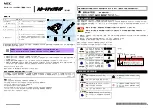
S e n d d o c u m e n t a t i o n c o m m e n t s t o m d s f e e d b a c k - d o c @ c i s c o . c o m
10-17
Cisco MDS 9000 Family CLI Configuration Guide
OL-16184-01, Cisco MDS SAN-OS Release 3.x
Chapter 10 Managing System Hardware
About Fan Modules
7 Outlet 75 60 33 ok
7 Intake 65 50 30 ok
9 Outlet 75 60 34 ok
9 Intake 65 50 39 ok
Example 10-5 Displays Temperature Information for Generation 2 Hardware
switch#
show environment temperature
---------------------------------------------------------------
Module Sensor MajorThresh MinorThres CurTemp Status
(Celsius) (Celsius) (Celsius)
---------------------------------------------------------------
1 Outlet1 75 60 33 ok
1 Outlet2 65 50 30 ok
1 Intake1 65 50 30 ok
1 LcFwdUp 65 50 35 ok
1 LcFwdDn 65 50 39 ok
1 FC-MAC 65 50 34 ok
6 Outlet1 75 60 33 ok
6 Outlet2 65 50 30 ok
6 Intake1 65 50 30 ok
6 Crosbar 65 50 35 ok
6 Arbiter 65 50 39 ok
6 CPU 65 50 34 ok
About Fan Modules
Hot-swappable fan modules (fan trays) are provided in all switches in the Cisco MDS 9000 Family to
manage airflow and cooling for the entire switch. Each fan module contains multiple fans to provide
redundancy. The switch can continue functioning in the following situations:
•
One or more fans fail within a fan module—Even with multiple fan failures, switches in the Cisco
MDS 9000 Family can continue functioning. When a fan fails within a module, the functioning fans
in the module increase their speed to compensate for the failed fan(s).
•
The fan module is removed for replacement—The fan module is designed to be removed and
replaced while the system is operating without presenting an electrical hazard or damage to the
system. When replacing a failed fan module in a running switch, be sure to replace the new fan
module within five minutes.
Tip
If one or more fans fail within a fan module, the Fan Status LED turns red. A fan failure could lead to
temperature alarms if not corrected immediately.
The fan status is continuously monitored by the Cisco MDS SAN-OS software. In case of a fan failure,
the following action is taken:
•
System messages are displayed.
•
Call Home alerts are sent (if configured).
•
SNMP notifications are sent (if configured).
Use the
show environment fan
command to display the fan module status (see
Example 10-6
).
















































